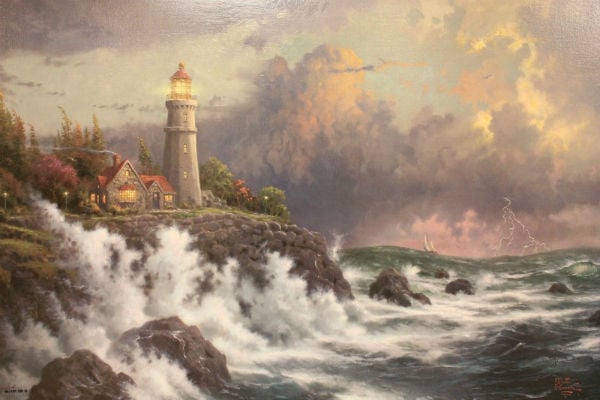Art World
Thomas Kinkade’s Legacy Will Outlive Us All


Ben Davis

The Daily Beast has a long (3,700-word) piece on the legacy of Thomas Kinkade today, “The Drunken Downfall of Evangelical America’s Favorite Painter.” That’s actually a fairly flat-footed title. Clearly the editor thought that the “conservative hypocrisy” angle was what would sell a piece about the Painter of Light to the Beast audience. But the recap of details about Kinkade’s divorce, tragic struggle with alcohol, fondness for strip clubs, and so on—all the real-life stuff belied by the sunny, “Morning in America” vibe of his mass-marketed prints and paintings—is well-trod territory.
The main interest of the story is obviously the details of how the Kinkade commercial juggernaut is holding up, two years after his death from a lethal combination of alcohol and Valium. In the immediate aftermath, there was a surge in demand for his art, which was clearly unlikely to last, and some uncertainty about whether the seamy circumstances and disputes over control of his estate would undercut his lucrative licensing deals.
This does not seem to be the case. In fact, you can expect a lot more Kinkade: the piece ends with a description of a secret vault containing massive amounts of original Kinkade works, and a quote from Patrick “The Brother of Light” Kinkade threatening that, “His legacy in terms of new publications will far outlive anybody who reads this article.”
The key paragraph is here:
ShopNBC’s sales of Kinkade products have risen in the two years since his death, with inspirational pieces like “Walk of Faith,” “Conquering the Storms,” and “A Peaceful Time” leading the way. After a natural slowdown following the postmortem craze, most Kinkade galleries report that their sales are a little higher than before his death. Not one of the company’s licensing partners ended its involvement with the brand following Kinkade’s death. They’ve been rewarded: Andrews McMeel Publishing says that sales of its Kinkade calendars rose 12 percent in 2012 and held that pace of sales last year. Hallmark has also seen double-digit growth, and Kinkade remains the top-selling painter of Disney images. The May 2014 issue of Global License! places Kinkade at #81 on its list of bestselling licensed brands, with $425 million in annual sales—ahead of CBS Consumer Products, National Geographic, and The Trump Organization.
I actually think there’s a bit of a lesson there. The Beast says that the ongoing success proves that his fans will just remember him as they want to, ignoring the complex reality. But I think this is an oversimplification.
Maybe I’m wrong, but I think it unlikely that Kinkade’s fans ever confused his small-town scenes with reality. His paintings’ insistence on unreal bucolic imagery reflected a keen underlying sense that the reality of contemporary America was full of moral peril (that’s part of Kinkade’s origin story, explicitly: he stated that he found himself living in despair in a “bombed-out ghetto,” finding salvation when he asked “the lord to be [his] art agent”). Divorce or struggles with addiction are hardly unusual problems (“Conservative Protestant community norms and the institutions they create seem to increase divorce risk,” says one recent study). It’s entirely possible, therefore, that awareness of Kinkade’s personal struggles makes the work more, not less, poignant to his admirers, and therefore more salable, as with any good tortured artist story.